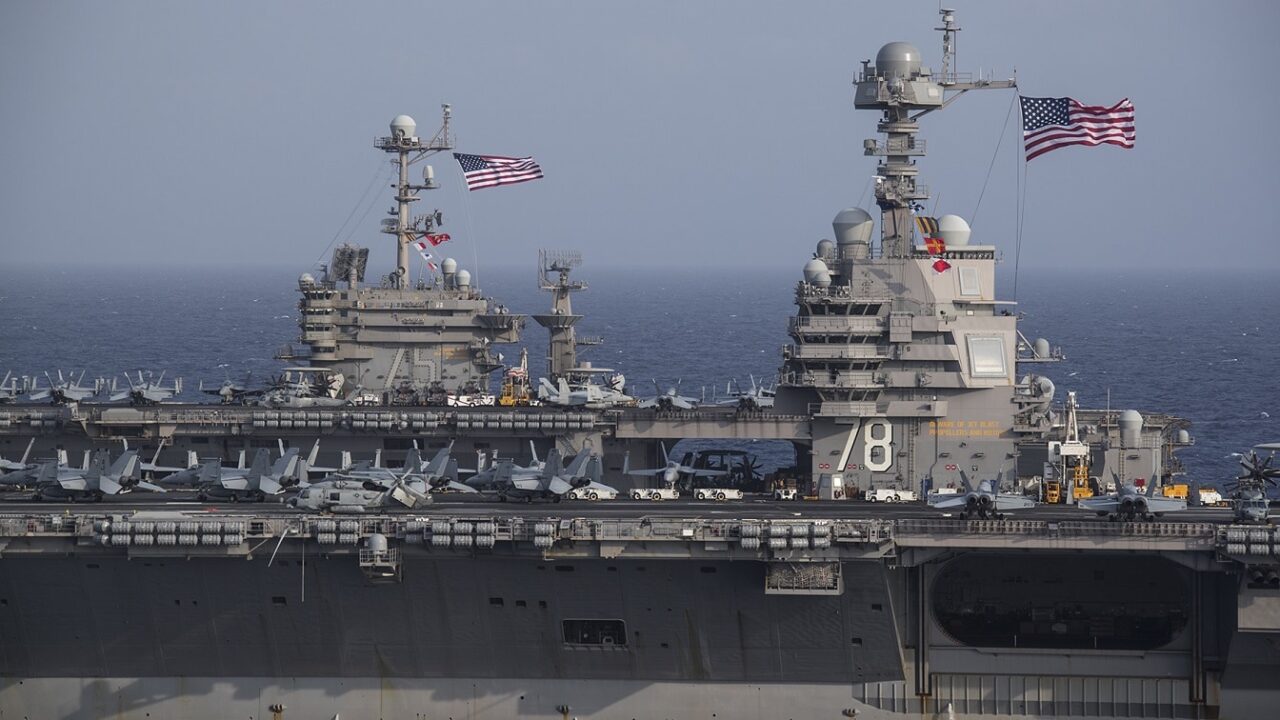Carrier Battlegroup Gives Options Against Iran – Placing a U.S. aircraft carrier strike group off the Iranian coast would stand as a reminder to Iran against further escalating of the current Mideast crisis that began on October 7 after Iranian-backed Hamas terrorists slaughtered 1,400 Israeli civilians.
The F-35s currently operating on American carriers are more than a match for Iran’s assortment of Cold War older fighters including the F-14, F-4, Mig-29, French Mirage F-1, and F-5 Tiger II.
And it does indeed look as if the U.S. Navy will send an aircraft carrier strike group to the Middle East. What could this mean for the region and the overall balance of power?
Create Vulnerability for Iran
Sending a carrier to the region matters for several vital reasons.
First, it would make Iran’s underbelly vulnerable if called upon should Tehran decline to de-escalate, but that requires the Biden administration to be willing to do more than just bluff.
“My warning to the ayatollah was that if they continue to move against those troops, we will respond, and he should be prepared. It has nothing to do with Israel,” President Joe Biden told reporters Wednesday.
Tough diplomacy requires and necessitates the credible threat of the use of force. Having a carrier battlegroup within striking distance of Iranian nuclear facilities and command and control sites could cause the Iranian regime to have to keep an eye on its backyard.
“If the White House and Pentagon want to show Iran that they are indeed serious about countering terror and deterring the spread of war throughout the region, it is essential they deploy a carrier strike group to the northern Indian Ocean, parking the carrier around 400 miles off the coast of Iran. The Islamic Revolutionary Guard Corps’ greatest deterrence to the U.S. Navy is its arsenal of anti-ship missiles, drones, and speedboats,” AEI Senior Fellow Michael Rubin wrote in a recent column in 19FortyFive.
Iran’s Antiship Deterrent
Iran has expended significant energy in figuring out how to sink an American aircraft carrier in the Persian Gulf.
Most effort has been placed on targeting American vessels operating in the Persian Gulf or the Straits of Hormuz.
“Iran’s A2/AD capabilities can be grouped into four broad categories: ballistic missiles, some of which could be armed with WMD warheads; unconventional warfare and terrorism by proxy, possibly made more lethal by G-RAMM weapons; maritime exclusion systems such as mines, ASCMs[anti-ship cruise missiles], and fast attack craft; and air defenses,” Franz-Stefan Gady of the Center for Strategic and Budgetary Analysis wrote in an April 2015 piece that appeared in The Diplomat.
Iran announced in July that it had developed and deployed a long-range cruise missile, the Abu Mahdi, that the Iranian Revolutionary Guard Corps (IRGC) claims has a range over 600 miles.
IRGC Navy Commander Rear Admiral Alireza Tangsiri claimed the range would keep carrier-borne aircraft from getting close enough to target Iran.
At this point, they stand as a reminder against escalation. Currently, the USS Gerald R. Ford stands in the Eastern Mediterranean as a deterrent Hizballah and Iran’s militia proxies in Syria.
The USS Dwight Eisenhower is indeed on its way to the Middle East and will pass through the Suez Canal.
Back to the Future: The 1980s and Iran Revisited
The U.S. finds itself in a situation that it has not faced since the 1980s.
The Reagan administration reflagged Kuwaiti oil tankers during the Iran-Iraq War and faced off against Iran under the protection of the World War II battleship USS Missouri.
It also faced off against Hizballah in Lebanon after the terrorist group blew up the Marine barracks in Beirut in 1983.
Aircraft from the carriers USS Independence and John F. Kennedy conducted operations over Lebanon that resulted in a botched airstrike on Syrian positions in the Bekaa Valley, and two A-6 Intruders were hit by anti-aircraft fire. The strike succeeded; however, the pilot succumbed to his injuries and the copilot ended up being held in a Damascus prison for two weeks.
The incident offers a reminder of what could go wrong without good planning and proper intelligence. The experience of the 1980s gives an example of what not to do. The carrier is the most visible example of American power projection.
John Rossomando is a defense and counterterrorism analyst and served as Senior Analyst for Counterterrorism at The Investigative Project on Terrorism for eight years. His work has been featured in numerous publications such as The American Thinker, The National Interest, National Review Online, Daily Wire, Red Alert Politics, CNSNews.com, The Daily Caller, Human Events, Newsmax, The American Spectator, TownHall.com, and Crisis Magazine. He also served as senior managing editor of The Bulletin, a 100,000-circulation daily newspaper in Philadelphia, and received the Pennsylvania Associated Press Managing Editors first-place award for his reporting.
From the Vault

